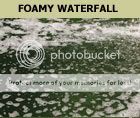I was at Petsmart today and picked up a few products that were on clearance. The first is Clearpond's Chloramine Buster. It states that it removes chlorine, chloramine and ammonia. The second is Clearpond's Beneficial Bacteria. The directions on the beneficial bacteria state that I need the ammonia level to be zero before I use it.
Now would be a good time to read up on
ammonium vs ammonia. And check out the
charts I mentioned earlier. Shouldn't freak you out. Every cloud has a silver lining and this one is yours. Repeat to yourself over and over "it's not an
ammonia test, it's a
total ammonia test".
You could check into a Seachem MultiTest Ammonia Test Kit. That can tell you actual ammonia vs ammonium and works even if a binder is added, at least for products like Prime and AmGuard. Probably Buster too, but you'd have to check.
Buy a water thermometer. That way you'll know whether or not to add an ammonia binder. The binder makes ammonia safe right? But I think you may already have safe ammonia. Water temp and the chart tells you. Keep in mind your test kit will still show what?
Total ammonia. Want to know how many people pour bottles of ammonia lock into their pond trying to reduce ammonia? Lots.
Take the Beneficial Bacteria back to the store. You already have the maximum amount of beneficial bacteria your pond can support. You always have the maximum...that's what they do for a living. Beneficial Bacteria in a Bottle, BBB, is a scam. Proven years ago to be a scam by lab coat dudes. There is a single company selling, or was, a BBB that was shown to work in some cases. It had to be refrigerated through the entire supply chain, like milk. And even in this case it only sped up the bio filter cycle by a day or two.
If my PH is too low, and I dont want to raise PH until zero ammonia...would it make sense to add Chloramine Buster now? Then when I have zero ammonia add Beneficial Bacteria? Then do something about PH?
Already went over you won't test 0 ammonia when you add Buster.
Water temp, chart, that will tell you where in the pickle you are located.
Want to get deeper into the pickle. Say you add Buster. Ammonia is safe now right? How do you know. Your ammonia test is the same, maybe higher. Now you're flying blind.
And water changes probably won't help you because that may only add more ammonia, bound ammonia, but you'd be flying blind again.
Keep listening to those cognitive functions, they're saving your butt.
What I personally would be shooting for is to raise pH and leave ammonia in place. The pickle is that this would normally kill the fish. Testing water temp, pH and ammonia will tell you if you're getting into danger and then you can add Buster. I don't like adding stuff because everything interacts with everything else. Buster (and all ammonia binders) create problems with some medical treatments. It makes everything more complicated. But if you have to, you have to.
In a perfect world you're going to get pH up some so bacteria can start converting ammonia, but not so high that ammonia becomes toxic. And water temp also has to be high enough for the bacteria. So a bit of a dance.
There's also a small risk that if for example you only raise KH and not GH that pH could shoot high and the ammonia blinders like Buster unbind at high pH levels, like 12. That's pretty high, but something to keep in the back of one's head.
I'd want pH reading a few times a day if you could manage. Morning and evening at least. These are your only eyes.
Another, not great, possibility is to move the fish to a holding tank. Then you can raise KH & GH (and pH) in the pond and not worry about the ammonia. Let the bacteria come on, and put the fish back.
You can also use Buster on your tap water to see how much ammonia is produced. That would tell you if water changes would help you. I'd also be very interested in the KH, GH and pH of your tab water.
There's a bottom line here at some point...I can tell you all kinds of stuff...but only you can understand your pond. I'm totally blind and could lead you right off a cliff. You have to see for yourself.


